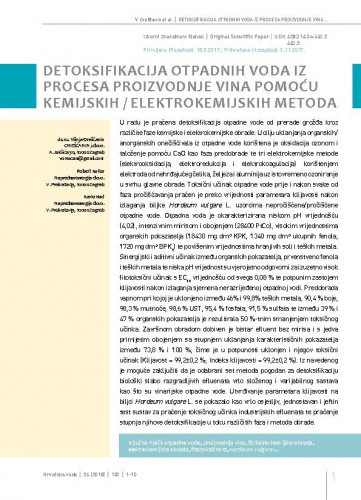U radu je praćena detoksifikacija otpadne vode od prerade grožđa kroz različite faze kemijske i elektrokemijske obrade. U cilju uklanjanja organskih/anorganskih onečišćivala iz otpadne vode korištena je oksidacija ozonom i taloženje pomoću CaO kao faza predobrade te tri elektrokemijske metode (elektrooksidacija, elektroredukcija i elektrokoagulacija) korištenjem elektroda od nehrđajućeg čelika, željeza i aluminija uz istovremeno ozoniranje u svrhu glavne obrade. Toksični učinak otpadne vode prije i nakon svake od faza pročišćavanja praćen je preko vrijednosti parametara klijavosti nakon izlaganja biljke Hordeum vulgare L. uzorcima nepročišćene/pročišćene otpadne vode. Otpadna voda je okarakterizirana niskom pH vrijednošću (4,02), intenzivnim mirisom i obojenjem (28400 PtCo), visokim vrijednostima organskih pokazatelja (18430 mg dm-3 KPK, 1340 mg dm-3 ukupnih fenola, 1720 mg dm-3 BPK5) te povišenim vrijednostima hranjivih soli i teških metala. Sinergijski i aditivni učinak između organskih pokazatelja, prvenstveno fenola i teških metala te niska pH vrijednost su vjerojatno odgovorni za izuzetno visok fitotoksični učinak s EC50 vrijednošću od svega 0,08 % te potpunim zastojem klijavosti nakon izlaganja sjemena nerazrijeđenoj otpadnoj vodi. Predobrada vapnom pri kojoj je uklonjeno između 46% i 99,8% teških metala, 90,4 % boje, 98,3 % mutnoće, 98,6 % UST, 95,4 % fosfata, 91,5 % sulfata te između 39 % i 47 % organskih pokazatelja je rezultirala 50 %-tnim smanjenjem toksičnog učinka. Završnom obradom dobiven je bistar efluent bez mirisa i s jedva primijetim obojenjem sa stupnjem uklanjanja karakterističnih pokazatelja između 73,8 % i 100 %, čime je u potpunosti uklonjen i njegov toksični učinak (Klijavost = 99,2±0,2 %; Indeks klijavosti = 99,2±0,2 %). Iz navedenog je moguće zaključiti da je odabrani set metoda pogodan za detoksifikaciju biološki slabo razgradljivih efluenata vrlo složenog i varijabilnog sastava kao što su vinarijske otpadne vode. Utvrđivanje parametara klijavosti na biljci Hordeum vulgare L. se pokazalo kao vrlo osjetljiv, jednostavan i jeftin test sustav za praćenje toksičnog učinka industrijskih efluenata te praćenje stupnja njihove detoksifikacije u toku različitih faza i metoda obrade..; The paper monitors detoxification of wastewater from the processing of grapes through various phases of chemical and electrochemical treatment. For the purpose of removing organic / inorganic pollutants from wastewater, oxidation with ozone and sedimentation with CaO were used as preliminary treatment phases as well as three electrochemical methods (electro-oxidation, electro-reduction and electro-coagulation) utilizing electrodes made of stainless steel, iron an aluminium, with a simultaneous ozonation as the primary treatment. The toxic effect of wastewater before and after each treatment phase was monitored through the values of the germination parameter after exposure of the plant Hordeum vulgare L. to the samples of untreated/treated wastewater. The wastewater was characterized by low pH value (4.02), intense odour and colouring (28400 PtCo), high values of organic pollutants (18430 mg dm-3 COD, 1340 mg dm-3 total phenols, 1720 mg dm-3 BOD5) and elevated values of nutrients and heavy metals. The synergic and additive impact among organic indicators, primarily phenols and heavy metals and a low pH value, were probably responsible for an extremely high phytotoxic impact with the EC50 value of only 0.08 % and a full cessation of the germination after the seed exposure to undiluted wastewater. A preliminary treatment with lime, which removed 46% - 99.8% of heavy metals, 90.4 % of colour, 98,3 % of turbidity, 98.6 % total suspended solids, 95,4 % of phosphates, 91.5 % of sulphates and 39 % - 47 % of organic indicators, resulted in 50 % toxic impact reduction. The final treatment resulted in clear effluent without odour and a barely noticeable colouring, with a removal degree of characteristic indicators from 73.8 % to 100 %, which also fully removed its toxic impact (germination = 99.2±0.2 %; germination index = 99.2±0.2 %). Based on the above stated, it can be concluded that the selected set of methods is suitable for detoxification of biologically poorly degradable effluents of a very complex and variable composition, such as wastewater from the wine-making process. The determination of the germination parameters on the plant Hordeum vulgare L. proved to be a very sensitive, simple and inexpensive test system for monitoring the toxic impact of industrial effluents and the degree of their detoxification in different treatment phases and with different methods.
Sažetak
Dio sveska

